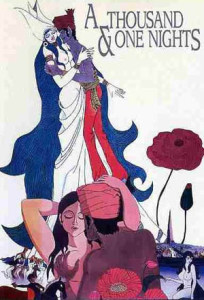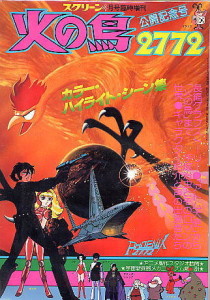Tezuka’s Anime (OAV)
Osamu Tezuka’s relationship with animation was a complex one.
At one end of the spectrum, he is, at least in regards to his career in anime, arguably most famous his work on his many animated television programs. On the other, Tezuka was equally enchanted with the idea of pushing the artistic boundaries of animation through his experimental animation short films. However between those two ends of the spectrum, almost exactly in the middle, sit Tezuka’s animated feature films.
For Osamu Tezuka the “holy grail” of animation was always to be able to produce full-length animated films for theatrical release. Animation on the BIG screen, like the animation crafted by his idol, Walt Disney, THAT was always his dream. Of course, the capital investment required to produce theatre-quality, feature length, animation was far beyond the means of the fledgling Mushi Productions, but that was the prize upon which he kept his eye.
Tezuka’s first foray into the world of animated films was somewhat limited. As a story consultant for Toei Animation during their adaptation of his manga series, Son-Goku the Monkey (1952-59) into the animated feature film known in English as Alakazam the Great (1960), he had little direct involvement in the process. He did, however, gain some useful experience – a resource he would draw on when it came time to release Mushi Productions’ first theatrical release, Astro Boy: The Hero of Space (1964).
Of course, for Tezuka this was only a stop-gap victory. Despite being a box-office success, since it was more or less a simple repackaging of his television content – essentially three episodes of the original Black & White Astro Boy (1963-66) series stitched together and produced partially in colour – it was still less than satisfying. The itch to produce a true animated theatrical release remained unscratched.
However, by the late 1960’s, Tezuka was ready to tackle a true “animerama” – a term Tezuka coined as an abreviation of “animated drama” – which was aimed at an adult audience and explored the possibilities of animation technology and cinematography. In early 1969 Tezuka put all the forces of both Mushi and Tezuka Productions to bear on the production of A Thousand and One Nights (1969), which hit theatres in June 1969 – incidentally premiering on the same day Tezuka’s second daughter, Chiiko, was born. The moderate success of A Thousand and One Nights (1969) led Mushi Productions to work on another, even more sexually charged, adult film and Cleopatra (1970) was released in September 1970.
Unfortunately, without the novelty factor inherent in A Thousand and One Nights (1969) as Tezuka’s first adult animated film, Cleopatra (1970) was largely given a pass by audiences of the time. The financial failure of Cleopatra (1970) proved to simply be a “bridge too far” for Mushi Productions – a studio already stretched to the limit by the need to produce television animation on the thinnest of margins. The lethal combination lead to the professional bankruptcy of Mushi Productions and his own personal financial ruin.
To his credit though, Tezuka remained undeterred by his failure and began to rebuild. Following a familiar path, he once again returned to working on projects for other studios and then repackaging his own television content. Although it took a decade of hard work, he was eventually able put Tezuka Productions in the position to release another theatrical film, Phoenix 2772: Space Firebird (1980).
While it was only a marginal success domestically, after Tezuka took it on the road with him it found more of an audience overseas – winning the Inkpot Award at the 1980 San Diego Comic Convention, and the Animation Award at the 1st Las Vegas Film Festival in 1980. As such, it is arguably (a pair of much-loved Unico films produced in cooperation with Sanrio aside) the pinnacle of Tezuka’s animated feature film achievements.
Frankly speaking though, that’s somewhat faint praise. All in all, his animated feature films were one area of Tezuka’s career where he was unable to reach the success he desired. The reasons for this are varied and complex, but in the end it seems he simply couldn’t strike the winning balance between commercial and artistic success that he was looking for.
| Title | Screened | Event/Location | Format | Length | Produced by |
| The Green Cat | 1983/10 (1989/07) | NHK Enterprises | Colour | 24 min. | Tezuka Productions |
| Rain Boy | 1983/12 (1989/07) | NHK Enterprises | Colour | 24 min. | Tezuka Productions |
| Lunn Flies into the Wind | 1985/04 (1989/07) | Toei Theatres | Colour/Toei Scope | 81 min. | Tezuka Productions |
| Astro Boy: The Hero of Space | 1964/07/26 | Nikkatsu Theatres | Part Colour | 87 min. | Mushi Productions |
| Jungle Emperor – The Movie | 1966/07/31 | Toho Theatres | Colour | 75 min. | Mushi Productions |
| A Thousand and One Nights | 1969/06/14 | Nippon Herald Films | Colour | 111 min. | Mushi Productions |
| The Gentle Lion | 1970/03/21 | Toho Theatres | Colour | 24 min. 41 sec. | Mushi Productions |
| Cleopatra | 1970/09/15 | Nippon Herald Films | Colour | 112 min. | Mushi Productions |
| World’s Famous Stories for Children: Thumbelina | 1978/03/18 | Toei Theatres | Colour | 64 min. | Toei Animation |
| Phoenix |
1978/08/19 | Toho Theatres | Colour | 138 min. | Toho/Hinotori Pro |
| Triton of the Sea – The Movie | 1979/07/14 | Toho Theatres | Colour | 74 min. | Office Academy |
| Phoenix 2772: Space Firebird | 1980/03/15 | Toho Foreign Films Theatres | Colour | 122 min. | Toho/Tezuka Prodcutions |
| The Fantastic Adventures of Unico-1 | 1981/03/14 | Sanrio Films | Colour Vista | 90 min. | Sanrio |
| The Fantastic Adventures of Unico-2: To The Magic Island | 1983/07/16 | Sanrio Films | Colour Vista | 91 min. | Sanrio |
| Phoenix: Hō-ō (Karma) | 1986/12/20 | Toho Foreign Films Theatres | Colour Vista | 60 min. | Kadokawa Haruki Office/Tohoku Shinsa |
| The Film is Alive | 1990/07/20 | Osamu Tezuka Exhibit | Colour | 42 min. | Tezuka Productions |
| Adachi ga Hara | 1991/11/16 | Theatre Ikebukuro | Colour | 25 min. | Tezuka Productions |




